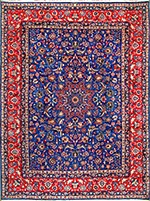Textiles Studies

Textile Research Works
Date of this Version
1996
Document Type
Article
Citation
Exhibition, THE TEXTILE MUSEUM, October 4, 1996 - February 23, 1997
Abstract
The beauty of oriental carpets is achieved by various means including choice of colors and designs, as well as by the manipulation of designs to form pleasing patterns. Patterns in Oriental carpets are never quite what you expect — a surprise here, a flourish there, a change of color, the flip or rotation of a design where you might not predict it. The more you look, the more variations you will find.
The study of symmetry offers an approach to analyzing patterns in Oriental carpets. Through symmetry analysis we may identify areas of pattern that exhibit expected repetitions, and areas that vary from that expectation.
What is a pattern? A pattern, whether in nature or art, is an arrangement of parts that consists of an organized system based upon repetition.
What is symmetry? Symmetry is a fundamental organizing principle. The analysis of symmetry allows for understanding the organization of a pattern, and for determining both invariance and change. Surprisingly, symmetry cannot exist without asymmetry.
What is asymmetry? Asymmetry is both the absence of symmetry, and the fundamental basis for symmetry. Symmetry analysis may result in the identification of a fundamental region that is the smallest element required to explain repetition that forms a pattern.
Although a design may be symmetrical or asymmetrical, the fundamental region that is repeated to form a pattern is asymmetrical. While possibilities for the composition of a design are limitless, the possibilities for manipulating a design to form a pattern are limited by symmetry.
Included in
Art and Materials Conservation Commons, Art Practice Commons, Fiber, Textile, and Weaving Arts Commons, Indigenous Studies Commons, Museum Studies Commons

